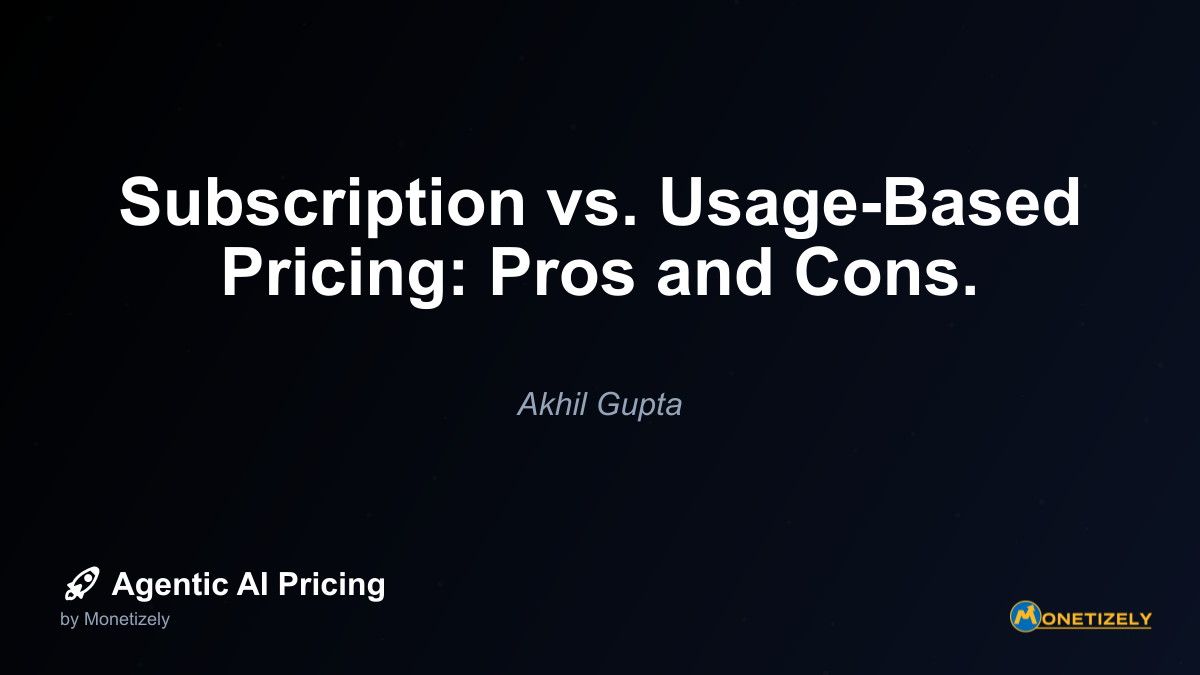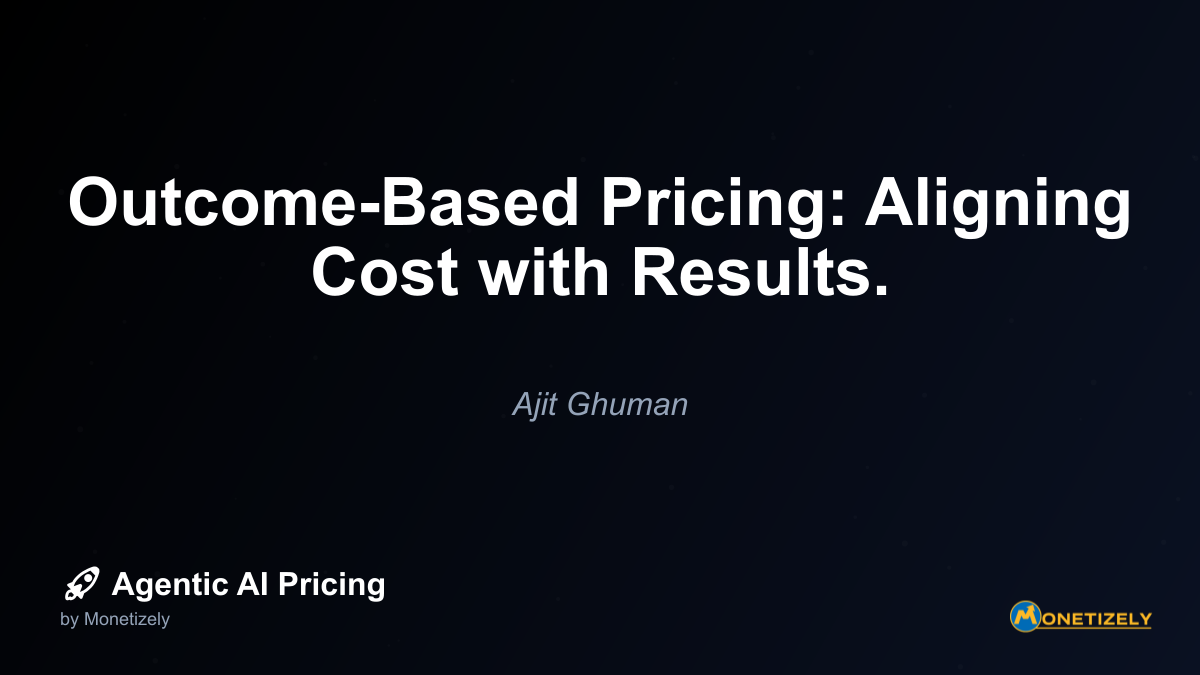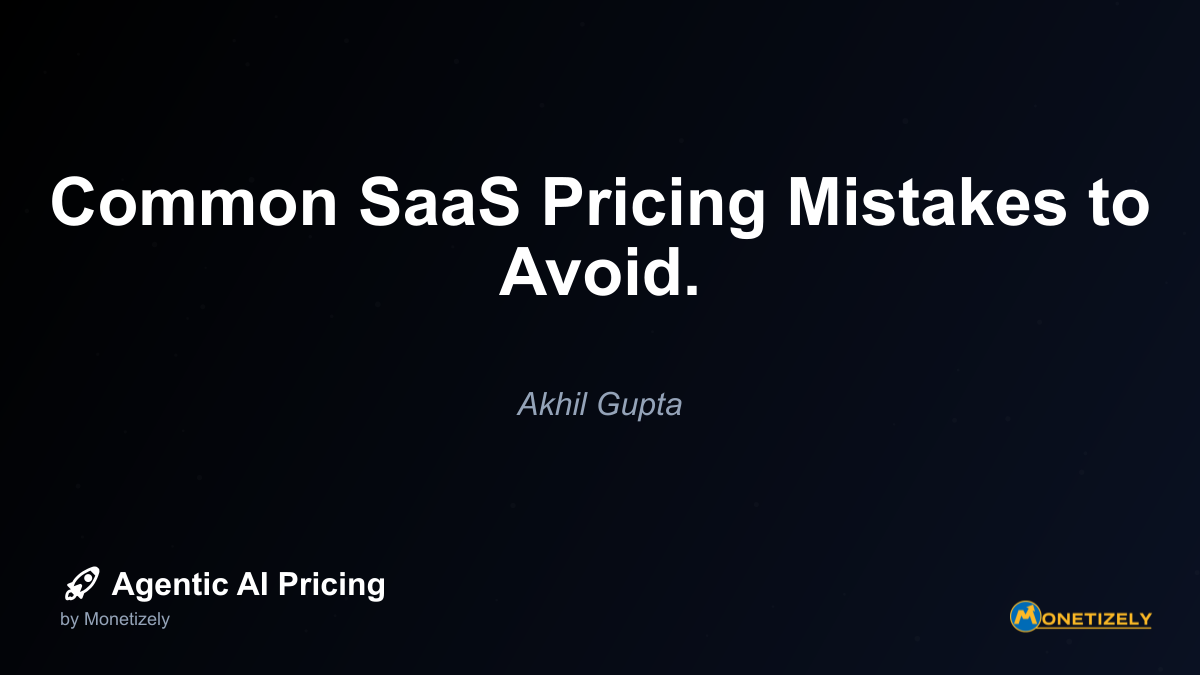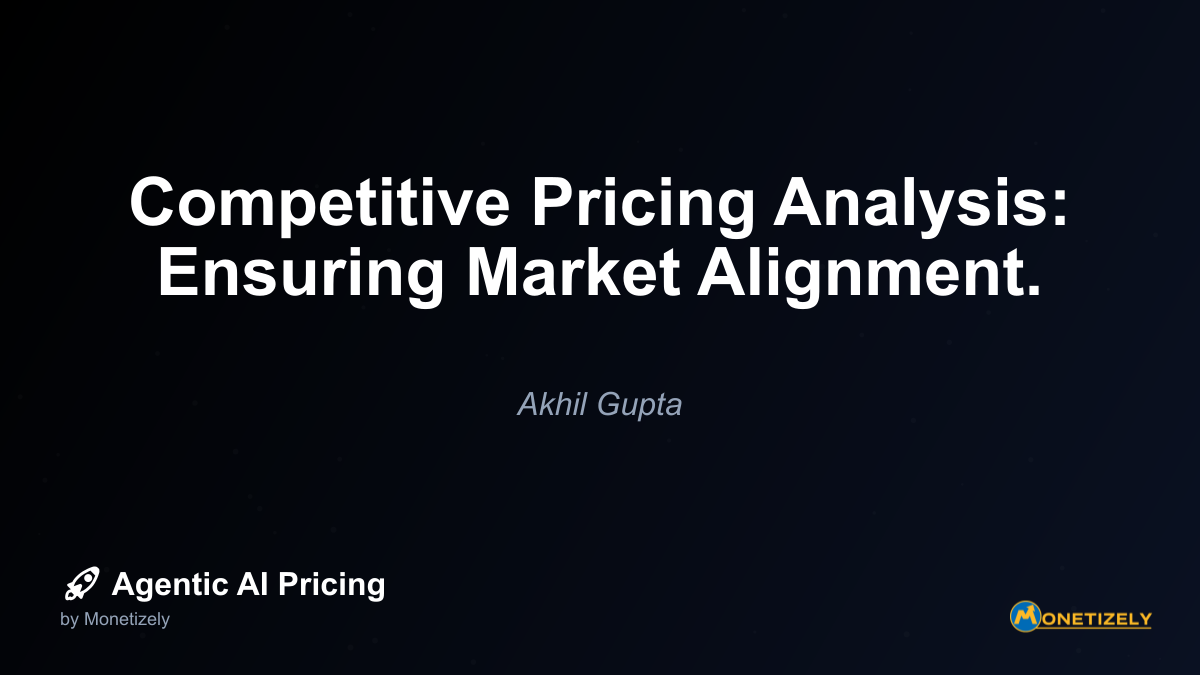· Akhil Gupta · Pricing Fundamentals · 9 min read
Overview of Software Pricing Models (Subscription, Usage, Outcome, etc.).
AI and SaaS Pricing Masterclass
Learn the art of strategic pricing directly from industry experts. Our comprehensive course provides frameworks and methodologies for optimizing your pricing strategy in the evolving AI landscape. Earn a professional certification that can be imported directly to your LinkedIn profile.
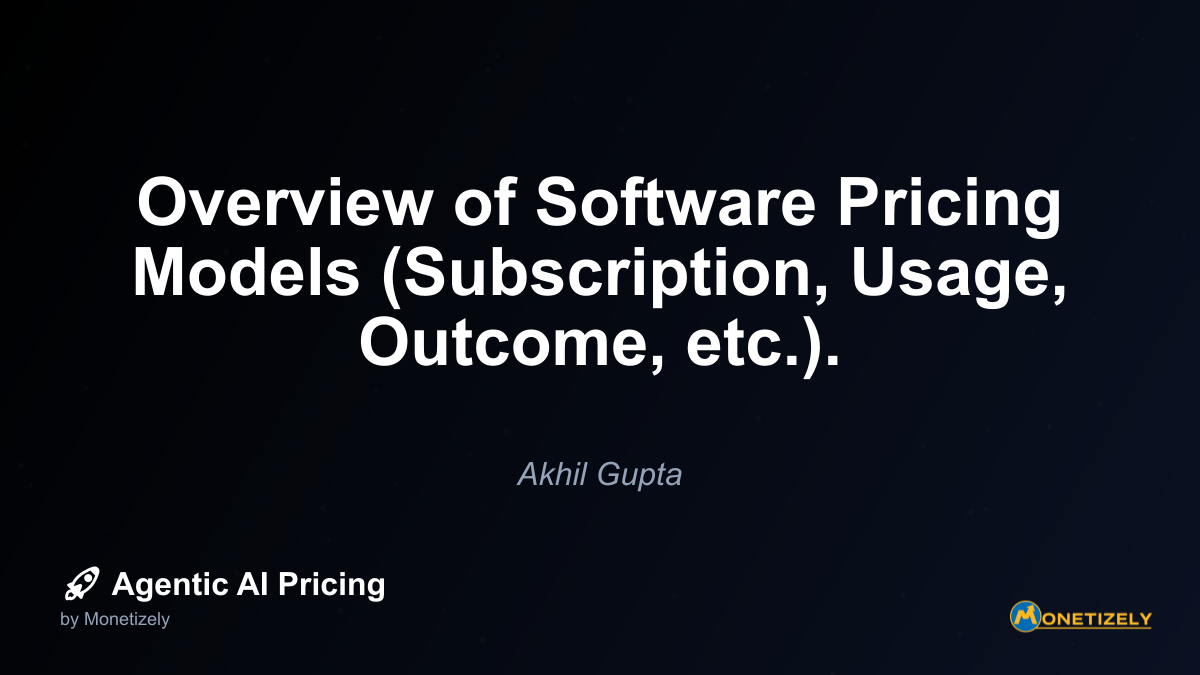
Software pricing models have evolved dramatically over the past decades, transitioning from one-time perpetual licenses to diverse approaches that align more closely with customer value. Today’s SaaS landscape features a rich variety of pricing strategies, each with distinct advantages for different business contexts. Understanding these fundamental models provides crucial groundwork for exploring the emerging pricing paradigms in agentic AI solutions.
The Evolution of Software Pricing
The software industry has witnessed a remarkable transformation in how products are monetized. In the early days, software was primarily sold through perpetual licenses—a one-time purchase granting indefinite usage rights. While this model provided immediate revenue, it created challenging boom-and-bust cycles for vendors who needed to constantly acquire new customers.
The introduction of cloud computing and SaaS delivery models catalyzed a shift toward recurring revenue approaches. This evolution wasn’t merely a technical change but represented a fundamental rethinking of the vendor-customer relationship. Rather than transactional interactions, software companies began building ongoing partnerships with their users, focusing on continuous value delivery and customer success.
Today’s software pricing landscape encompasses numerous models, each designed to address specific business objectives, customer preferences, and value propositions. Let’s explore the most prevalent approaches and their respective strengths and weaknesses.
Subscription-Based Pricing Models
Subscription pricing has become the dominant paradigm in the SaaS industry, offering predictable recurring revenue for vendors and manageable ongoing costs for customers.
Flat-Rate Subscription
The simplest subscription model involves charging a consistent fee (typically monthly or annually) for unlimited access to a product or service. Companies like Netflix and Adobe Creative Cloud exemplify this approach.
Advantages:
- Straightforward for customers to understand
- Highly predictable revenue for the vendor
- Simplified billing and accounting processes
- Lower customer acquisition costs through long-term relationships
Disadvantages:
- Limited flexibility for different usage levels
- Potential for leaving money on the table with high-value users
- May create barriers for small customers or those with limited needs
Flat-rate subscriptions work best for products with relatively homogeneous usage patterns or where usage measurement doesn’t correlate strongly with perceived value.
Tiered Subscription
Tiered subscription models offer several distinct packages at different price points, each providing a specific set of features, capabilities, or usage limits. This approach, used by companies like Salesforce, HubSpot, and Zoom, allows vendors to segment their market and capture value across diverse customer segments.
Advantages:
- Accommodates different customer segments with varying needs
- Creates natural upsell pathways as customers grow
- Enables strategic feature differentiation
- Provides entry points for smaller customers while capturing more value from larger ones
Disadvantages:
- Can create artificial feature limitations that frustrate customers
- Potentially complex to communicate and maintain
- May lead to customer dissatisfaction if essential features are restricted to higher tiers
Effective tiered pricing requires careful consideration of which features drive value for different customer segments and how to structure meaningful differentiation between tiers.
Per-Seat Licensing
Per-seat or per-user licensing charges based on the number of individuals using the software. This model, popularized by companies like Microsoft Office 365, Slack, and Monday.com, scales pricing directly with the breadth of deployment within an organization.
Advantages:
- Naturally scales with customer size and value received
- Simple to understand and implement
- Aligns pricing with a clear value metric (number of users)
- Creates predictable expansion revenue as customers grow
Disadvantages:
- May discourage full deployment across an organization
- Can lead to seat-sharing and account misuse
- Sometimes disconnected from actual value delivered
- Potential for high costs in large organizations
Per-seat models work best when individual user access represents a clear value unit and when the software delivers consistent value to each additional user.
Usage-Based Pricing Models
Usage-based pricing (sometimes called consumption-based or pay-as-you-go) ties costs directly to actual consumption of resources or services. This approach has gained significant traction, particularly in infrastructure, data processing, and API-driven services.
Pure Usage-Based
In pure usage-based models, customers pay only for what they consume, typically measured in units like API calls, compute hours, storage volume, or transactions processed. AWS, Google Cloud Platform, and Twilio exemplify this approach.
Advantages:
- Direct alignment between cost and value
- Low barrier to entry for new or small customers
- Eliminates waste and unused capacity
- Scales efficiently with customer growth
Disadvantages:
- Unpredictable costs for customers
- Revenue uncertainty for vendors
- Potential for bill shock with unexpected usage spikes
- Complex to communicate and forecast
Pure usage-based models work best for infrastructure services, APIs, and utilities where consumption directly correlates with value and where usage patterns can vary significantly.
Hybrid Usage Models
Many companies combine usage-based elements with subscription components, creating hybrid models that provide both predictability and alignment with consumption. These often take the form of subscriptions with usage tiers, overage charges, or included usage allowances.
Snowflake’s data warehousing platform exemplifies this approach, charging for compute resources consumed while on a subscription plan. Similarly, Mailchimp offers email marketing plans with included send volumes and additional charges for exceeding those limits.
Advantages:
- Balances predictability with usage alignment
- Creates a baseline of recurring revenue
- Provides some cost certainty for customers
- Captures additional value from high-consumption users
Disadvantages:
- More complex to understand and communicate
- Requires sophisticated billing systems
- May still cause bill shock when overages occur
- Can create artificial usage constraints
Hybrid models have become increasingly popular as they mitigate the downsides of both pure subscription and pure usage approaches.
Outcome-Based Pricing Models
Perhaps the most sophisticated pricing approach, outcome-based models tie costs directly to business results achieved through the software. This value-based pricing directly aligns vendor compensation with customer success.
Performance-Based Pricing
Performance-based models link payment to specific, measurable outcomes like revenue generated, cost savings achieved, or performance improvements. For example, some digital advertising platforms charge based on actual conversions rather than impressions or clicks.
Advantages:
- Perfect alignment between price and value
- Reduces customer risk
- Creates strong vendor incentives for customer success
- Potentially higher margins when outcomes are achieved
Disadvantages:
- Requires clear, measurable outcomes
- Complex to implement and track
- May involve revenue recognition challenges
- Introduces revenue uncertainty for vendors
Performance-based models work best when outcomes are clearly attributable to the software and when those outcomes can be reliably measured.
Gain-Sharing Models
Gain-sharing takes outcome-based pricing further by establishing a partnership where the vendor receives a percentage of the value created. This approach is common in procurement software (savings-as-a-service) and in certain enterprise optimization solutions.
Advantages:
- Creates true partnership dynamics
- Potentially higher revenue capture when value is high
- Compelling for customers focused on ROI
- Differentiates from traditional subscription offerings
Disadvantages:
- Requires sophisticated value tracking
- Complex contractual arrangements
- Longer sales cycles and implementation
- Challenges in establishing baseline measurements
Gain-sharing models are most effective for high-value enterprise solutions with clearly quantifiable financial impacts.
Freemium and Free Trial Models
While not standalone pricing models, freemium and free trial approaches represent important go-to-market strategies that complement core pricing structures.
Freemium
Freemium offers a limited but functional version of the product at no cost, with premium features available through paid upgrades. Companies like Dropbox, Slack, and Calendly have used this approach to drive adoption.
Advantages:
- Reduces acquisition costs through organic growth
- Creates broad awareness and product education
- Leverages network effects
- Provides qualification data for sales targeting
Disadvantages:
- Risk of free users never converting
- Support costs for non-paying users
- Challenging to balance free/paid feature boundaries
- Potential for devaluing the core product
Freemium works best for products with strong network effects, low marginal costs, and clear premium value tiers.
Free Trials
Free trials provide full product access for a limited time, allowing customers to experience the complete value proposition before committing. Most SaaS companies employ some form of trial in their acquisition strategy.
Advantages:
- Reduces purchase risk for customers
- Accelerates the sales cycle
- Creates opportunities for guided onboarding
- Demonstrates full product value
Disadvantages:
- Can attract unqualified users
- May require significant support resources
- Potential for trial abuse
- Conversion challenges at trial end
Effective free trials require thoughtful onboarding, appropriate qualification, and strategic conversion tactics.
Emerging Pricing Innovations
The software pricing landscape continues to evolve, with several innovative approaches gaining traction:
Value-Metric Pricing
Value-metric pricing bases costs on specific metrics that directly correlate with customer value, such as the number of projects, contacts managed, or transactions processed. This approach, used by companies like HubSpot (contacts) and Intercom (active users), aims to find the perfect proxy for value delivery.
Dynamic Pricing
Dynamic pricing adjusts rates based on factors like demand, customer segment, usage patterns, or competitive conditions. While common in industries like hospitality and transportation, it’s beginning to appear in software contexts, particularly for high-volume, commoditized services.
Bundling and Unbundling
Strategic bundling packages multiple products or features together at advantageous rates, while unbundling separates components for à la carte purchase. Companies frequently oscillate between these approaches as market conditions and competitive landscapes evolve.
How to Choose the Right Pricing Model
Selecting the optimal pricing model requires careful consideration of several factors:
Value Alignment: Choose a model that closely tracks how customers derive value from your solution.
Customer Preferences: Consider how your target customers prefer to purchase and budget for software.
Market Expectations: Understand the established norms in your category while identifying opportunities for differentiation.
Business Objectives: Align your pricing strategy with broader goals like market penetration, revenue maximization, or profitability.
Operational Capabilities: Ensure your organization can effectively implement and manage the chosen model.
Competitive Landscape: Position your pricing strategically relative to alternatives available to your customers.
Growth Strategy: Select a model that accommodates and accelerates your planned growth trajectory.
The most successful companies often implement hybrid approaches that combine elements from multiple models to create a unique pricing strategy aligned with their specific value proposition and market position.
Implications for Agentic AI Pricing
As agentic AI solutions enter the market, they present unique pricing challenges that build upon these foundational models. The autonomous, adaptive nature of agentic AI introduces new dimensions to consider:
Value Quantification: How do you price systems that autonomously generate value in unpredictable ways?
Usage Complexity: What constitutes “usage” when AI agents operate continuously or intermittently on behalf of users?
Outcome Attribution: How do you attribute business outcomes to AI agents that work alongside human teams?
Risk Allocation: How should pricing reflect the potential risks and uncertainties of autonomous systems?
Capability Expansion: How should pricing adapt as AI agents learn and improve their capabilities over time?
These questions suggest that agentic AI pricing will likely evolve beyond traditional software models, potentially incorporating elements of outcome-based approaches, sophisticated usage metrics, and dynamic pricing adjustments based on performance and value delivery.
Conclusion
The diverse landscape of software pricing models offers a rich foundation for developing effective monetization strategies. From straightforward subscriptions to sophisticated outcome-based approaches, each model presents distinct advantages and challenges for different business contexts.
As organizations evaluate their pricing approaches, they should focus on aligning costs with value delivery, creating sustainable customer relationships, and establishing pricing structures that can evolve alongside their products and markets. The most effective pricing strategies often combine elements from multiple models to create unique approaches tailored to specific value propositions and customer segments.
For companies entering the agentic AI space, understanding these foundational models provides crucial context for developing innovative pricing strategies that address the unique characteristics of autonomous, adaptive AI solutions. As this technology continues to evolve, so too will the approaches to capturing its value through thoughtful, strategic pricing.
Co-Founder & COO
Akhil is an Engineering leader with over 16+ years of experience in building, managing and scaling web-scale, high throughput enterprise applications and teams. He has worked with and led technology teams at FabAlley, BuildSupply and Healthians. He is a graduate from Delhi College of Engineering and UC Berkeley certified CTO.
Pricing Strategy Audit
Let our experts analyze your current pricing strategy and identify opportunities for improvement. Our data-driven assessment will help you unlock untapped revenue potential and optimize your AI pricing approach.

